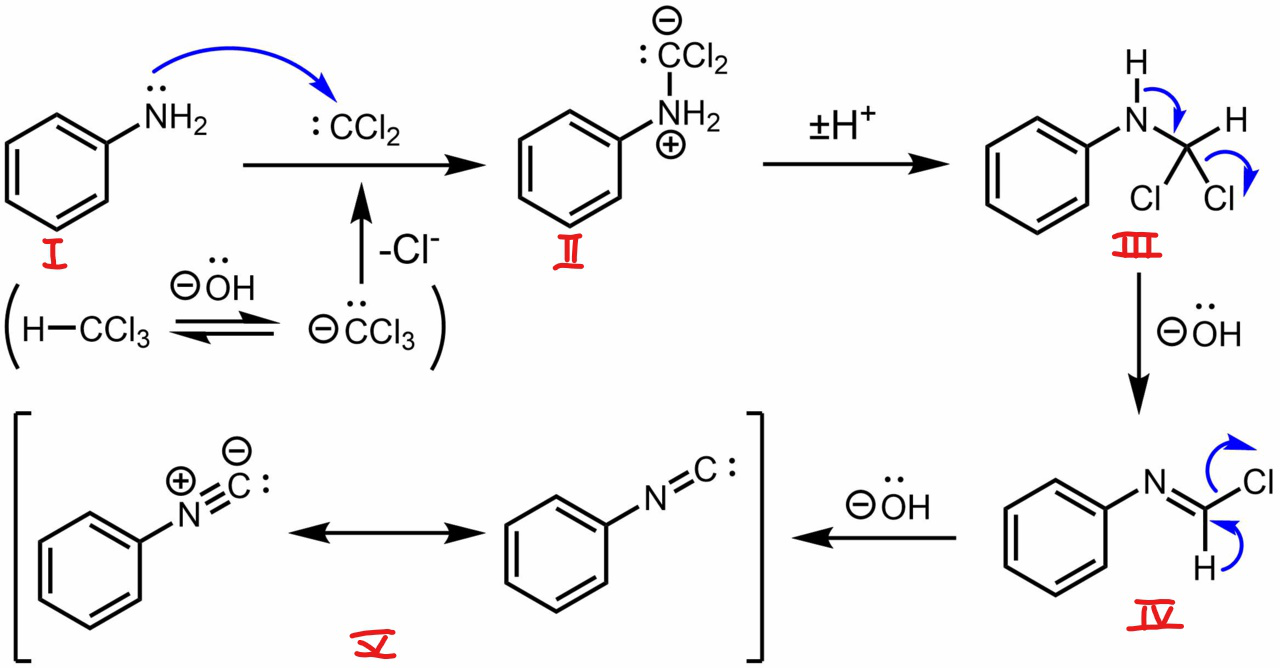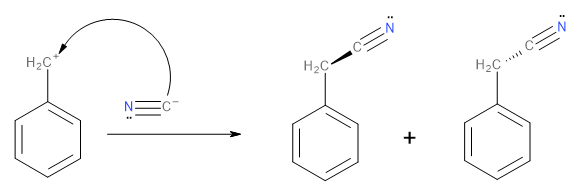
The bad smelling substance formed by the action of alcoholic caustic potash on chloroform and aniline is:
A. Phenyl isocyanide
B. Nitrobenzene
C. Chloropicrin
D. Acetylene
Answer
224.4k+ views
Hint: The reaction between aniline and chloroform (\[CHC{l_3}\]) in the presence of alcoholic potash (\[KOH\]) is called the carbylamine reaction. The product of the carbylamine reaction is a bad-smelling substance.
Complete Step by Step Solution:
Primary amines (\[R - N{H_2}\]) undergo a reaction known as the carbylamine reaction (or the Hofmann isocyanide synthesis reaction) with alcoholic potash (\[KOH\]) in the presence of chloroform (\[CHC{l_3}\]). The product of the carbylamine reaction is a class of organic compounds called isocyanides or carbylamines (\[R - NC\]) that contain the isocyanide functional group (\[ - NC\]).

Image: The carbylamine reaction
Isocyanides are very well-known for their disagreeable odour, to the point that they have been investigated as potential non-lethal weapons.
The isocyanide that forms when aniline reacts with alcoholic potash and chloroform is called phenyl isocyanide (also known as isocyanobenzene). The reaction is shown below.

Image: Carbylamine reaction of aniline
Thus, the correct option is A.
Additional Information:
Alcoholic potash is responsible for converting the chloroform into dichlorocarbene which is the reactive intermediate of this reaction. The dichlorocarbene is then attacked by the nucleophilic nitrogen atom of the primary amine. Subsequent eliminations of hydrochloric acid molecules lead to the formation of carbylamine. The mechanism is shown below.

Image: Mechanism of the carbylamine reaction
Note: It is important to remember that this reaction will produce a mixture of products which will be racemic. This is because the benzyl carbocation is planar. Thus, the cyanide ion can attack it from either side of the plane. This leads to the formation of a racemic mixture of 2-phenylacetonitrile. Remember that all\[{S_N}1\] reactions lead to the racemisation of the product.

Image: Racemic mixture
Complete Step by Step Solution:
Primary amines (\[R - N{H_2}\]) undergo a reaction known as the carbylamine reaction (or the Hofmann isocyanide synthesis reaction) with alcoholic potash (\[KOH\]) in the presence of chloroform (\[CHC{l_3}\]). The product of the carbylamine reaction is a class of organic compounds called isocyanides or carbylamines (\[R - NC\]) that contain the isocyanide functional group (\[ - NC\]).

Image: The carbylamine reaction
Isocyanides are very well-known for their disagreeable odour, to the point that they have been investigated as potential non-lethal weapons.
The isocyanide that forms when aniline reacts with alcoholic potash and chloroform is called phenyl isocyanide (also known as isocyanobenzene). The reaction is shown below.

Image: Carbylamine reaction of aniline
Thus, the correct option is A.
Additional Information:
Alcoholic potash is responsible for converting the chloroform into dichlorocarbene which is the reactive intermediate of this reaction. The dichlorocarbene is then attacked by the nucleophilic nitrogen atom of the primary amine. Subsequent eliminations of hydrochloric acid molecules lead to the formation of carbylamine. The mechanism is shown below.

Image: Mechanism of the carbylamine reaction
Note: It is important to remember that this reaction will produce a mixture of products which will be racemic. This is because the benzyl carbocation is planar. Thus, the cyanide ion can attack it from either side of the plane. This leads to the formation of a racemic mixture of 2-phenylacetonitrile. Remember that all\[{S_N}1\] reactions lead to the racemisation of the product.

Image: Racemic mixture
Recently Updated Pages
JEE Main 2025-26 Mock Test: Organic Compounds Containing Nitrogen

JEE Main 2025-26 Organic Compounds Containing Nitrogen Mock Test

JEE Main Chemical Kinetics Mock Test 2025-26: Free Practice Online

JEE Main 2025-26 Organic Compounds Containing Oxygen Mock Test

JEE Main 2025-26 Organic Compounds Containing Halogens Mock Test

Sodium acetate on heating with soda lime produce A class 12 chemistry JEE_Main

Trending doubts
JEE Main 2026: City Intimation Slip and Exam Dates Released, Application Form Closed, Syllabus & Eligibility

JEE Main 2026 Application Login: Direct Link, Registration, Form Fill, and Steps

Understanding the Angle of Deviation in a Prism

How to Convert a Galvanometer into an Ammeter or Voltmeter

Hybridisation in Chemistry – Concept, Types & Applications

Ideal and Non-Ideal Solutions Explained for Class 12 Chemistry

Other Pages
NCERT Solutions For Class 12 Chemistry Chapter 1 Solutions - 2025-26

JEE Advanced Marks vs Ranks 2025: Understanding Category-wise Qualifying Marks and Previous Year Cut-offs

Solutions Class 12 Chemistry Chapter 1 CBSE Notes - 2025-26

NCERT Solutions ForClass 12 Chemistry Chapter Chapter 4 The D and F Block Elements

Biomolecules Class 12 Chemistry Chapter 10 CBSE Notes - 2025-26

NCERT Solutions For Class 12 Chemistry Chapter 10 Biomolecules - 2025-26




